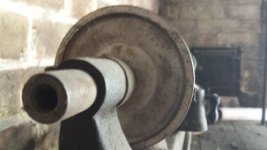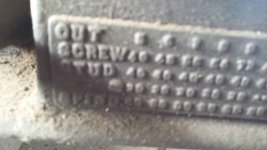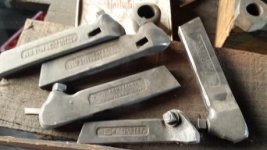Bier:
In regard to the "unidentified" item made by Channon:
I agree it is a winch. It was likely originally hand powered. You mention the house has been in the family over 100 years, which- for me at least- is a clue about the winch. Years ago, homes were heated with coal. The furnace or boiler was in the basement. Getting the ashes up from the basement and out to the curb (if the house were in a city) for pickup by ash removal wagons (later, trucks) was always a job. I am 66 years old, and grew up calling steel garbage cans "ash cans", even though my boyhood home had been converted to oil heat. Getting a can full of coal ash and clinker up to the street was a hard job. Some homeowners had steel carts which had a set of claws for gripping the bottom and top rims of the ashcans. Dragging the cart with a barrel of ashes up the basement steps required a householder to be in good physical shape.
Some households with deeper basements, or simply to relieve the householders of having to drag full ashcans up the basement steps, had ashcan hoists. These used hand winches and often incorporated a small jib crane, if a shaft opening was provided for hoisting out the ashcans vertically- this being more common in commercial buildings or larger multiple dwellings. In single and two family homes, the usual basement entrance had a set of steps and the ashcans had to come up those steps for ash disposal. An inclined track or a kind of ramp was used. This was a set of angle iron tracks with a dolly or sled. The ashcans were placed on the dolly or sled and the winch was then used to draw the dolly or sled up the track/ramp to street elevation. In houses where there was no outside basement entrance- as might be the case in cities with an attached or semi attached house- the ashes had to come out via the basement windows. This was done using a sheet steel ashbin or "skip", and the winch hauled it up and thru the window on a ramp or track.
My guess is someone got sick and tired of hauling ashes by hand and decided to motorize the winch. The winch may well have been a simple capstan, which turned continuously. A few turns of rope were taken around it, and when the free end of the rope were pulled taut, the capstan gripped the rope and began hauling it in. The original winch may well have used a hemp rope or small-diameter wire rope. Being hand-cranked, and having a worm gear drive, the winch could be turned to raise or lower the load and would hold the load when the cranking stopped. With an attempt to power the winch with a motor, getting a reversible single phase motor might have been something that was either too expensive or beyond the means and skills of the person doing the conversion. Back "in the day", people such as your great grandfather were thrifty and resourceful and tended to use whatever was at hand rather than buying things. An old motor from a washing machine or refrigeration compressor (back in the early days of home refrigerators, compressors were not the sealed units or today, and were belt driven) was often used in home workshops to drive tools such as bench grinders and saws. Such a motor would have been likely to be used to drive the winch, and was usually not reversible. Hence, the winch was converted to a capstan.
I heat my home with a coal fired boiler (using an oil fired boiler as backup). I fill what is called a "half barrel"- a corrugated steel short garbage can- with ashes about every 2nd or 3d day during the heating season. I wheel the ashcan thru my shop, carry it up the stair into the garage, then back on another hand truck for dumping on the driveway. The ash and clinker mix and compact with the "choke" (crushed stone and stone dust) in the driveway. It is what people did "back in the day", and the coal ash and clinker are great for throwing on an icy driveway and icy walkways and steps. I am guessing your great grandfather, being a home shop machinist and mechanic, was looking for a way to get around lugging ashbins or ash cans up out of the basement or to avoid cranking a worm geared winch to do it. A worm geared winch, cranked by hand, is about as slow a means of raising a load as it gets. Your great grandfather was obviously a resourceful man and his home shop equipment speaks of a man who made do with what was at hand.

























